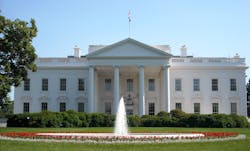Election 2016 — Which Outcomes Should Transit Fans Cheer For?
The unprecedented elections of 2016 will no doubt be long remembered for a variety of reasons. Whether you are for Donald Trump to “Make America Great Again,” or if you “Stand with Hillary Clinton,” there has been little real discussion of the substantive issues at a time when the stakes are high. With control over both the White House and the U.S. Senate on the line, the outcome of the November elections will have a profound impact on the future of the federal surface transportation program in the coming years. Putting all other issues aside, let’s take a look at the evidence we have from the Presidential campaign trail, the candidates’ records and the party platforms to try to make an educated guess on what outcomes would be most beneficial to the future of public transportation in America.
The Candidate Platforms
For most of the entirety of this seemingly endless campaign season, both major party presidential nominees have had little to say about their plans for addressing our nation’s infrastructure crisis or improving our public transportation in America. However, in recent weeks, some detail has emerged. Here is the tale of the tape:
The Clinton Platform
Hillary Clinton wants to invest in America’s infrastructure in a big way. She has proposed an increase in federal investment in our nations’ infrastructure of $275 billion over the next five years. Of that total, $25 billion would be dedicated to the establishment of a National Infrastructure Bank, which she believes will leverage another $225 billion in capital through loans, and loan guarantees and other debt instruments. She proposes to pay for this plan by generating revenue through tax reform — closing loopholes, repatriation of overseas corporate holdings, and charging an “exit tax” on domestic companies that choose to move their activities overseas. Her plan also proposes an expansion of the popular Build America Bonds program, and encourages public-private partnerships.
If this plan sounds familiar, it’s because it closely resembles proposals that have been advanced by the Obama Administration over the past few years. To put the numbers in perspective, the recently passed FAST-Act authorizes $301 billion in spending over the next five years for highway, transit and rail programs. The spending increase would amount to about $580 billion per year, although the investments would be divided among transportation, water, broadband and other types of infrastructure priorities. This figure is slightly more than proposals floated by the current Administration, and far short of the amounts needed to address the $1.4 trillion investment gap by 2025 for surface transportation, according to the American Society of Civil Engineers. Moreover, these funding levels have been routinely rejected by the current Republican Congress. Using “tax reform” as a payment mechanism would require an overhaul of the U.S. tax code — a popular sentiment that also has gained little traction in Congress.
The Clinton campaign has also directly addressed the need to invest in public transportation. Her platform states: “Clinton will prioritize and increase investments in public transit to connect Americans to jobs, spur economic growth and improve quality of life in our communities.” This rhetoric, found on her campaign website, places particular emphasis on the importance of public transportation to connect low-income families in urban areas to economic opportunities, such as education and job centers. This language is very similar to ideas advanced through the Obama administration’s “Ladders of Opportunity” program. While the Clinton campaign accurately highlights one of the important roles of transit in the U.S., it could go further to highlight some of the other important benefits of the federal transit program, such as the positive economic and environmental impacts of congestion reduction, building more livable communities or attracting a millennial work force.
A look at Hillary Clinton’s record during her time in the Senate reveals strong support for public transportation — not surprising considering her New York constituency. She consistently voted for pro-transit legislation, was a strong supporter of major projects such as the MTA’s 2nd Avenue Subway, and even introduced legislation such as the “Saving Energy through Public Transportation Act,” which would have substantially increased the federal investment in transit. There is no doubt that a Clinton victory would place a transit advocate in the White House. The primary question is will she have the fortitude to make infrastructure investment a top priority, and solve tough issues such as the insolvent highway trust fund.
The Trump Platform
Donald Trump has repeatedly stated that America needs to invest in its “crumbling infrastructure.” However, as of press time, his campaign has not offered a detailed proposal how his Administration would address the funding gap. On the bright side, statements by the candidate seem to reveal a break from the traditional conservative approach from his own Republican party. Fresh off the heels of the unveiling of Clinton’s proposal, Trump announced in an interview with Fox Business Network that he would double his rival’s investment levels, stating that “we need much more money to rebuild our infrastructure. I would say at least double her numbers, and you’re going to really need a lot more than that.”
On several occasions, Trump has stated that America needs to invest in the development of an advanced high-speed rail and public transit system. He believes the nation should be taking advantage of low interest rates to borrow money to pay for transportation improvements, including the creation of a special bond program that would allow companies and individual citizens to invest in the improved network.
There is more. As reported by Martine Powers (Dr. Gridlock) of the "Washington Post" in his excellent article, "The Irony of the GOP’s New Promise to Cut Mass Transit Funding? Donald Trump Loves Trains" (July 20), Trump noted in the preface of his 2015 book, “Crippled America: How to Make America Great Again:”
"Domestically, we need to undertake a massive rebuilding of our infrastructure. Too many bridges have become dangerous, our roads are decaying and full of potholes, while traffic jams are costing millions in lost income for drivers who have jobs in congested cities. Public transit is overcrowded and unreliable and our airports must be rebuilt. You go to countries like China and many others and you look at their train systems and their public transport. It’s so much better. We’re like a third-world country."
Powers goes on to add that Trump has told multiple parties that he wanted to be the “Greatest Infrastructure President” in the nation’s history.
Considering Trump’s background as a business tycoon and real estate investor, along with his New York upbringing, his views on public transportation cannot be surprising. Of course, as with much of what Trump says, it’s difficult to know what to make of Trump’s grandiose statements. There is little detail to analyze, but one must conclude that his plan would face the same challenges — in size and financing mechanism — that Clinton’s would. The good news is that at least both candidates seem to recognize the problem and favor substantial increases in transportation investments. In the long run, success will depend on either candidates ability, if victorious, to convince Congress to make these sorts of commitments.
The Party Platforms
Another source of insight into the core philosophies of each party lies in the official party platforms, adopted at the both the Republican and Democratic nominating conventions in July. Although not officially endorsed by Congressional leadership, the party platforms provide policy guidance used by their respective parties at both at the executive and legislative level. With the control of the U.S. Senate at stake in the coming elections, the platforms should not be ignored.
The Republican Platform
For transit advocates, the Republican Party platform is disaster. While acknowledging the need to improve roads, bridges and other forms of infrastructure, the party platform directly attacks public transportation investments by the federal government. The short-sighted document states “We (The Republican Party) propose to remove from the Highway Trust Fund programs that should not be the business of the federal government. More than a quarter of the Fund’s spending is diverted from its original purpose. One fifth of its funds are spent on mass transit, an inherently local affair that serves only a small portion of the population, concentrated in six big cities,” and “we propose to phase out the federal transit program.” The document goes on to label Amtrak as a waste of taxpayer money, proposes to privatize the Northeast passenger rail corridor, and end federal support for “boondoggles like California’s high-speed train to nowhere.”
This backwards approach represents a view of public transportation that was rejected by a Republican controlled Congress less than two years ago, and certainly does not reflect statements made by their parties’ own Presidential nominee. It must be noted that this view of our nation’s transportation program, and indeed much of the platform as whole, has been widely rejected by a significant portion of the more moderate members of the Republican party.
The Democratic Platform
The Democratic platform is friendlier to transportation interests, but lacks specific proposals. Its most relevant discussion of infrastructure states: “If we are serious about reversing the decline of the middle class, we need major federal investments to rebuild our crumbling infrastructure and put millions of Americans back to work in decent paying jobs in both the public and private sectors. The climate emergency and the need to expand the middle class demand that we make the most ambitious investment in American infrastructure since President Eisenhower created the Interstate highway system. We will put Americans to work updating and expanding our roads, bridges, public transit, airports, and passenger and freight rail lines.”
The one interesting policy revelation is linking infrastructure investments to the “climate emergency" — perhaps a nod to the notion that more investment in public transportation and rail infrastructure can reduce carbon emissions. While the Democratic platform does not make transportation investment a large priority, at least it does not outwardly attack the federal transit and passenger rail programs.
As we progress into this election season and attention turns to debates, town hall meetings and campaign speeches, here’s to hoping that we will see a true discussion of the importance of investing in our nation’s transportation infrastructure, and the emergence of thoughtful policy solutions. It certainly would be refreshing to see blank policy generalizations and personal attacks exchanged for a discussion of solutions to our nation’s most pressing domestic issues. In the meantime, we are left with culling through website copy, vague interview statements and puzzling party platforms to guess what the impact of this election will really mean for the future of the federal surface transportation program. So in the end, I leave it to you, wise voter to choose for yourself and hope for the best.
Paul Dean is the director of Dean & Dean Consulting LLC.
About the Author

